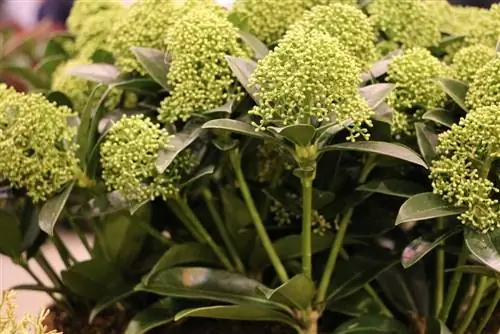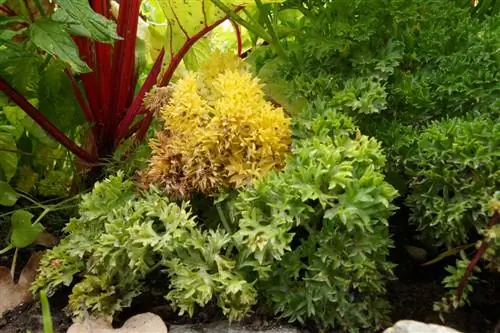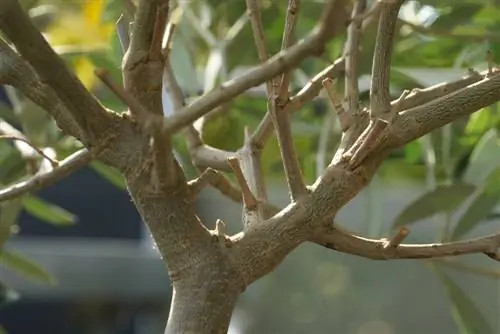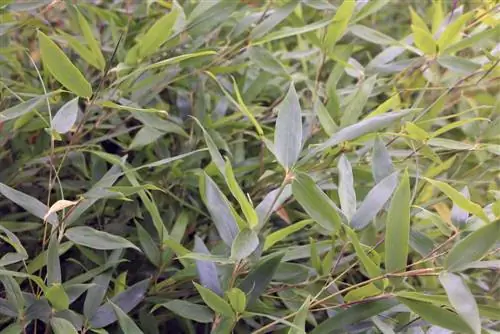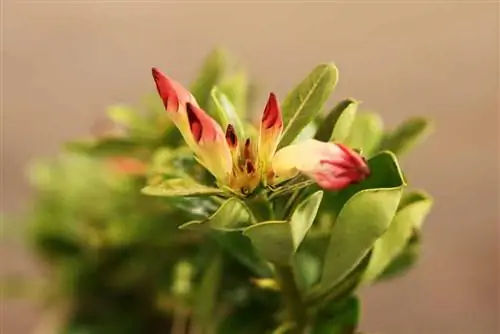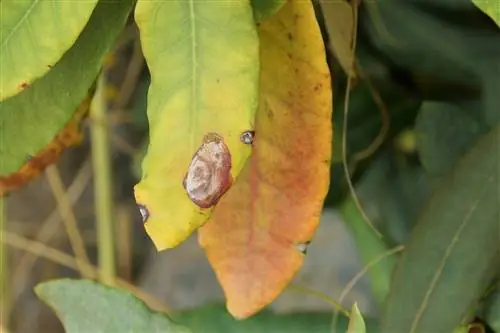- Author admin [email protected].
- Public 2023-12-17 03:39.
- Last modified 2025-01-24 12:45.
In winter, a distinctive small shrub stands out in the garden with evergreen leaves, which maintain a decorative dialogue with bright red berries until March. In spring, the Asian charm offensive continues with wonderfully fragrant flowers. Thanks to skimmie, dreary niches in locations with little light are now a thing of the past. A Skimmia japonica is only reserved when it comes to the demands on its care. Read here how to properly water, fertilize and cut the multi-faceted ornamental tree. Here you will also find tried and tested help with yellow leaves.
What is the difference between fruit skimmia and flower skimmia?
If there is a solitary skimmia in the bed and on the balcony, you will look in vain for the bright red fruit in autumn. The decorative ornamental tree is a bisexual plant. This property implies that at least one female and one male Skimmia japonica must be in close proximity to each other for successful pollination to occur.
In spring, both bushes bear white, fragrant flowers that, to a layperson, cannot be distinguished by gender. The distinction is easier when purchasing. Specialist retailers offer a male skimmie under the name 'flower skimmie'. The female counterpart is labeled as a 'fruit skimmie'.
Location in the bed
Creative home gardeners benefit from their decorative properties in the bed. In order for the hope of the red berry decorations over an evergreen foliage to be fulfilled, the choice of location is an important criterion. A look at its Asian homeland shows where a Skimmia japonica feels in good hands. In the mountain forests of East Asia, the pretty small shrub lies at the feet of majestic trees, whose crowns filter the sunlight. Therefore, assign the ornamental tree in the bed a location with the following conditions:
- Sunlit to partially shaded location
- Flowers and berries thrive only sparsely in the shade
- Humid, warm and protected
- Nutritious, fresh to moist garden soil
- An acidic pH of 5.0 to 6.5
Against the dark backdrop of a conifer hedge or as an underplanting of coniferous trees, the decorative flower and fruit trees come into their own. Likewise, a Skimmia japonica feels right at home in the company of rhododendrons, hydrangeas and azaleas. Wherever there is no blazing sun or full shade and a fresh, acidic garden soil supports the roots, the skimmie brings you floral moments of happiness in winter and spring.
Location on the balcony
If you want colorful accents on your balcony in winter and a sea of flowers in spring, you have made a smart choice with skimmias. If the small shrubs in the pot are protected from the blazing winter sun and bitter frost, they can remain outdoors all year round. To prevent the pots from tipping over, a location protected from the wind is recommended. To ensure pollination, one male flower skimmia and one female fruit skimmia should be potted in each planter.
Substrate
Since the Asian rhombus plant wants a nutrient-rich and acidic soil, we recommend rhododendron or azalea soil for pot cultivation, enriched with expanded clay or lava granules for good ventilation and permeability. By adding a little clay, the stability of the pot and balcony box is optimized.
Tip:
As a houseplant, the skimmie feels uncomfortable because it suffers greatly from dry heating air. If at all, the ornamental tree in the pot should be placed in a partially shaded window seat at a cool 10 to 15 degrees Celsius, where humidity of more than 60 percent is ensured.
Pouring
The watering intervals do not follow a fixed schedule. Rather, there is always a need for water when the soil on the surface is noticeably dry. Waterlogging and drought stress can be avoided by checking the moisture content of the root disc daily using a finger test. How to properly water a skimmie:
- Always use stale tap water or filtered rainwater
- Do not allow skimmie to dry out at any time
- Let the soil and substrate dry slightly between waterings
- Pour out the saucer in the pot after 10 minutes
On the balcony you will water the small shrub more often, as the root ball dries out quickly due to its exposed location, especially in summer. Since Skimmia japonica, as an evergreen tree, evaporates moisture even in winter, continue to water when it is dry. However, from September onwards the amount of water will be gradually reduced and will only continue at a low level. The plant then stops growing in the fall so that no new shoots grow that would freeze in the winter.

Tip:
A layer of mulch in the bed and pot protects the soil from dryness. Bark mulch, leaves or pine needles are well suited.
Fertilize
During the growth and flowering period, your skimmie is grateful for additional nutrients, as the evergreen leaves, the fragrant flowers and the magnificent berry decorations take a lot of energy. The following options are available for supply in the bed and on the balcony:
- Fertilize the bed every 4 weeks from March to August with acidic leaf or needle compost
- Alternatively, spread a low-lime fertilizer in March and June, rake in and water
- Administer a liquid fertilizer for ericaceous plants in the pot and balcony box every 14 days
- Press fertilizer sticks with long-term effect into the substrate in spring and summer
We recommend fertilizing for the last time at the end of August with potassium-rich comfrey manure, a liquid potassium fertilizer or Thomaskali from specialist retailers. An extra portion of potassium lowers the freezing point in cell water and strengthens cell tissue. In September, the supply of nutrients ends at the same time as the amount of water is reduced. In this way, you underline the winter hardiness of the ornamental shrub, as it is better prepared for frosty temperatures when it is dormant.
Cutting
In view of the leisurely growth of 5 to 10 cm per year, scissors are rarely used on a Skimmia japonica. Under the influence of the Central European climate, the attractive shrub only reaches its maximum height of 100 to 120 cm uncut after 10 years or later. Professional pruning distinguishes between the female fruit skimmia and the male flower skimmia. With this cut you will do everything right:
- On male plants, only cut off the withered flowers in summer if necessary
- Short shoots that are too long until just above a sleeping eye
- Do not trim or prune female plants after flowering
- Think out a skimmia in late winter every 1 to 2 years
By cutting back a fruit skimmia after flowering, you deprive the plant of its seed heads and thus of decorative berries in autumn and winter. In contrast, after the flowering period, a male plant has fulfilled its role as a pollinator and can be cut back to the desired size. However, both Skimmia japonica should be cleaned regularly of dead wood and frozen branches so that they do not become bare from the inside because light no longer reaches them.
Tip:
The skimmia is slightly poisonous in all parts. In particular, the red berries are not suitable for human consumption. The birds in the garden, on the other hand, are extremely happy about the valuable source of food in winter.
Wintering
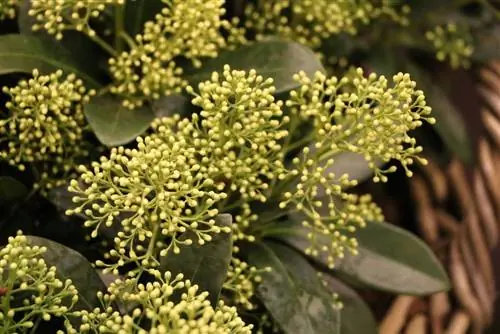
The more woody a skimmia has progressed, the more frost-resistant the shoots are. Therefore, some precautions must be taken in the bed, at least during the first 5 years, to ensure that the small shrub remains he althy and cheerful. Protective measures are on the agenda in pots and balcony boxes every late autumn. How to overwinter a Skimmia japonica successfully:
- Watering gradually less from August onwards without causing dryness of the bales
- Do not apply fertilizer from September to March
- Mulch on the root disk in the bed before the first frost with leaves and conifers
- Place the pot and balcony box on wood and cover it with insulating material
- Cover the substrate with leaves, straw or wood wool
If the mercury column exceeds the freezing point in late winter and spring, the winter protection is removed. This is especially true for organic mulch layers, as rot could form underneath due to condensation.
Repotting
A skimmia takes several years to root through its pot. However, if root strands grow out of the opening in the ground, the small shrub signals its desire for a larger container with fresh soil. The best time for this measure is in spring, between the end of winter dormancy and the beginning of the flowering period. Here's how to do it step by step:
- In the new planter there is a maximum of 2 finger-widths of space between the root ball and the edge
- Expanded clay or clay shards above the floor opening act as protection against waterlogging
- An air and water permeable fleece between the drainage and substrate prevents siltation
- Pour a few handfuls of fresh soil over the fleece
- Insert the potted skimmia while maintaining the previous planting depth
Shake off the used substrate from the root ball and you will have a clear view of the root system. This is a good opportunity to remove dead, diseased strands with sharp, disinfected scissors. After the ornamental shrub has settled into the new substrate, water moderately. Fertilization is only carried out after 4 to 6 weeks after repotting, as the soil has a reserve of nutrients.
This helps with yellow leaves
With yellow leaves, the evergreen skimmia becomes significantly less attractive. In the long run, the graceful small shrub will die if adequate measures are not taken to combat this damage. The focus is on 3 common causes of yellowed leaves, which are examined in more detail below, supplemented by helpful tips for solving the problem.
Leaf chlorosis
A skimmie lacks any tolerance to lime. Therefore, every expert care instruction insists on using acidic soil with a pH value of 5 to 6. If only hard water is used for watering, the pH value skyrockets because the lime content accumulates. As a result, vital iron is stored in the soil and can no longer be transported through the roots to the foliage. The leaves then turn yellow while the green veins still shine through. This helps:
- From now on, only water the affected skimmia with lime-free water
- Repotting potted plants in acidic rhododendron soil
- Underground peat or ericaceous soil in the bed without damaging the roots
In order to compensate for the lack of iron and magnesium as quickly as possible, we recommend foliar fertilization with liquid iron fertilizer. Preparations such as Neudorff Ferramin iron fertilizer or Foliovit from Terraflor are water-soluble as chelates. Dissolved according to the manufacturer's instructions, spray all the leaves of the skimmia on the bottom and top surfaces. To prevent the liquid preparation from dripping straight away, add a few drops of dishwashing liquid. It is important to note that the fertilizer is not sprayed into the flowers and not under direct sunlight.
Sunburn
As an Asian forest plant, the skimmie does not know direct sunshine. If the ornamental shrub in the bed or on the balcony is exposed to the sun, yellow, curling leaves are inevitable. An indication of sunburn are yellow spots where the sun hits. If these bright yellow spots do not spread further, it is a site problem and not a disease or leaf chlorosis. Move the plant immediately to a partially shaded place. It is beneficial if the yellow leaves are not cut off as the remaining green tissue continues to contribute to photosynthesis.
Nutrient Deficiency
If leaf chlorosis and sunburn can be ruled out as the cause, it is most likely a nutrient deficiency. Since Skimmia japonica, as an evergreen shrub, does not shed its leaves, it urgently needs additional nutrients, especially during the growth and flowering period. If there is a deficiency here, it removes the last remnants from the foliage in order to invest them in the flowers and berries that guarantee continued existence. As a result of this displacement, the leaves turn yellow. This helps:
- From spring to the beginning of autumn, fertilize the bed every 3 to 4 weeks with acidic compost
- Additional fertilizer with Thomaskali at the end of August/beginning of September
- Add liquid fertilizer to the watering water every 14 days on the balcony from March to August

When choosing fertilizer, make sure that it is low in lime. A fertilizer that is declared for rhododendron, azalea or hydrangea also covers the nutrient needs of a skimmia.
Conclusion
The skimmia delights with fragrant spring blossoms, evergreen leaves and red berry decorations. In order for the floral gem from the forests of East Asia to feel at home in our latitudes, a partially shaded, protected location is important. The soil should be acidic, fresh, moist and nutrient-rich, because a Skimmia japonica may have nothing to do with lime. In summer, the substrate should be constantly slightly moist, using primarily soft water. An acidic fertilizer in solid or liquid form every 2 to 4 weeks guarantees vitality and flowering. In August, the winter care program is modified by reducing the amount of water and stopping the supply of nutrients. If you still have yellow leaves, the most common causes are leaf chlorosis, sunburn and nutrient deficiency. How to react correctly to these triggers is no longer a secret after reading this guide.

